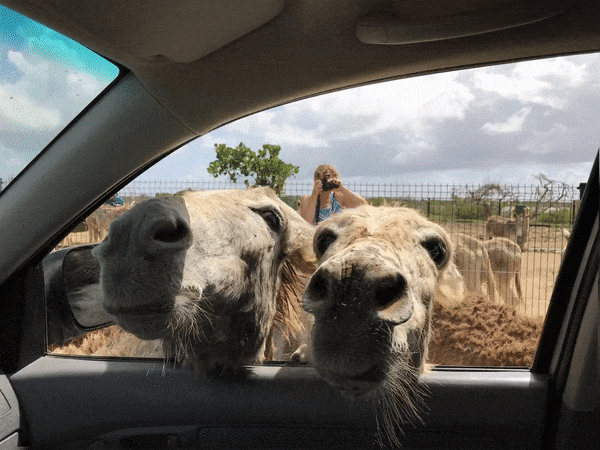Bonaire is a desert island in the south Caribbean that’s known for fantastic coral reefs, flamingos, sea salt production, and donkeys. Coral, flamingos, and salt occur naturally in Bonaire. Donkeys—not so much.
In the 1600s Spaniards brought donkeys to the island to haul salt and equipment. Once more modern transportation was available, however, they abandoned the donkeys to their own fate. The donkeys roamed the island, fending for themselves, without oversight or caretakers.
But Bonaire isn’t the most hospitable environment for donkeys. Between the arid climate and increased tourism, many donkeys fell victim to illness and car accidents. They’re also an invasive species and eat any moisture-laden plants they can find.
That brings us to the obvious part of the story: the Donkey Sanctuary. The sanctuary was started in 1993 to care for sick, injured, and orphan donkeys. Volunteers and donations helped care for the several hundred donkeys the sanctuary took in. Here are a couple of sanctuary residents:
Take care of injured donkeys, get them out of the wild and reduce their impact on the native plants and animals, and reduce donkey-human conflict. Sounds like something everyone can get behind—obviously a good thing, right?
It turns out that not everyone sees it that way. There is a petition (supported by 3000+ people) to maintain Bonaire’s wild donkey population.
They argue that the sanctuary’s practice of sterilizing male donkeys will eventually lead to the extinction of donkeys on the island. And for them, that’s a problem.
After 450 years, even though they’re not indigenous, these wild-donkey supporters view the donkeys as part of their culture and heritage. They also have concerns about humane treatment for donkeys within the sanctuary.
Their bottom line: they want the donkeys to remain wild and for people to treat them well.
Why They Can’t See the Obvious
Has that ever happened to you?
You’ve figured out a great solution to an irritating problem and unveil it, only to find out that—not only do people dislike your solution, but they don’t even see your problem as a problem.
When people can’t see what’s obvious to you, it’s not that they’re obstinate, ignorant, or broken.
People are different. They’ve had different experiences, different values, and different personalities. They’re looking at the world through all of those filters—just like you do.
This is one of the critical roles leaders provide: to bring together the varied perspective, craft a shared picture of what’s possible, and help everyone work toward it. (If it were obvious to everyone, the situation would probably already be resolved, and no leadership needed.)
How to Lead When Your Team Can’t See the Obvious
It’s frustrating when your team doesn’t get it and can’t see what’s obvious to you. But if you run ahead of them and insist on what makes sense to you without discussion, you will eventually lose your team.
Here are a few ways you can lead when your team can’t see the obvious path you see:
Clarify who owns the decision
Before you start the discussion, be clear about who decides. Will you decide? Will the team vote? Or will you work for consensus? This helps everyone know how to engage and think about what they hear.
Present the Problem
Share the challenge from your perspective. Explain why you believe it is a problem. The consequences that you see every day might be invisible to your team. They may not understand why those issues are important. Take the time to present the issue and give people the information they need to see what you see.
Get Their Insights
Find out what is obvious to them. Take time to listen. Specifically, look for the “right” in their perspective. What is it that makes such obvious sense to them that they’ll wonder how you could be so blind?
Land in the And
It’s not always possible, but once you’ve identified the issues obvious to everyone and found the value in different perspectives, look for ways to “land in the and.” Ask a “How can we?” question that combines the major values. Eg “How can we limit harm to the donkeys, protect native vegetation, and continue to experience the 450 years of wild donkey culture?”
When you ask “How can we?” questions that include the obvious elements of different perspectives, you can often find creative solutions that make far more sense and have more support than the limited, but “obvious” approach.
It’s not always possible to craft a solution that meets every need, but when you have the conversations, you help your team to think the way you do, you’re made smarter from the perspectives they bring, and the team is far more likely to own the outcome going forward.

